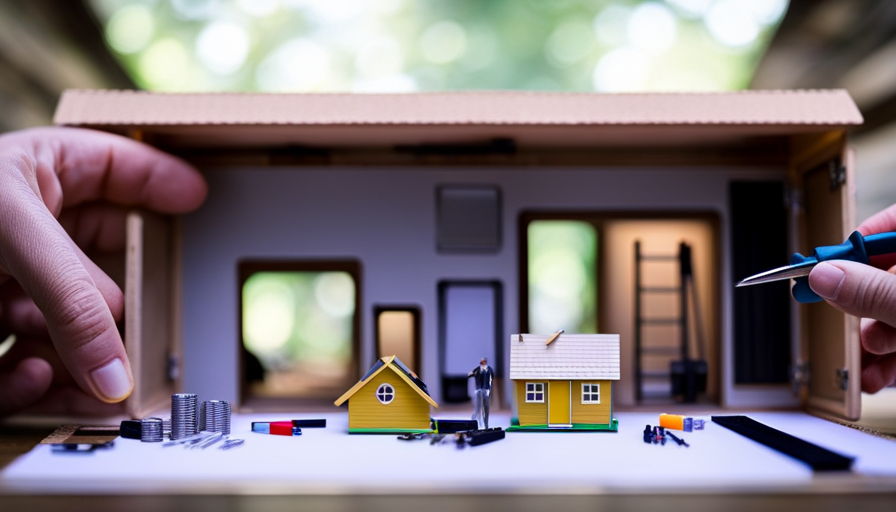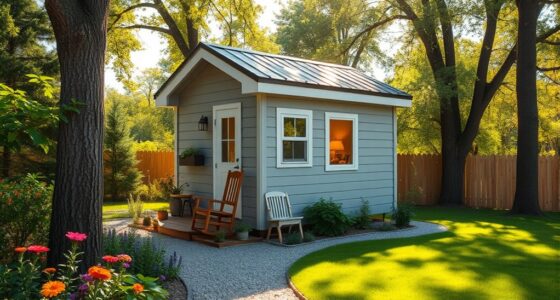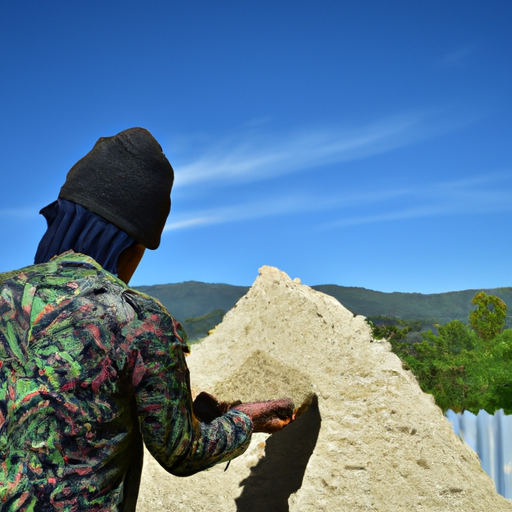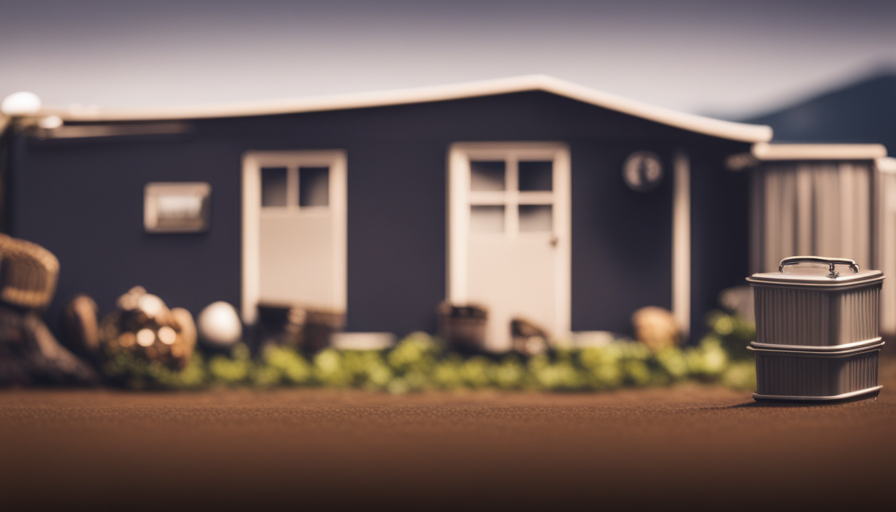Imagine living in a cozy, compact home that perfectly suits your needs and lifestyle. A place where you can simplify, save money, and focus on what truly matters to you. Welcome to the world of tiny house living!
In this article, we’ll explore the states that have embraced the tiny house movement and created thriving communities for like-minded individuals seeking simplicity and freedom.
Take California, for example. With its progressive mindset and environmentally conscious population, it’s no surprise that the Golden State is home to numerous tiny house communities. But California is not alone.
Other states such as Oregon, Colorado, Texas, Florida, and North Carolina have also joined the tiny house revolution, offering unique opportunities for those looking to downsize and live a more sustainable lifestyle.
Join me as we dive into the fascinating world of tiny house communities across the United States.
Key Takeaways
- California and Oregon have progressive regulations and diverse tiny house communities, making them popular destinations for those interested in tiny house living.
- Colorado offers opportunities for a sustainable lifestyle and communal living through its tiny house communities.
- Texas has unique tiny house communities in Austin and Houston, with Austin offering regulations and benefits for tiny house living.
- Florida is a popular destination for tiny house living due to its warm climate, beautiful landscapes, and communities with amenities. However, it also has regulations and zoning laws to consider.
California
If you’re looking to embrace the minimalist lifestyle and join a tight-knit community of tiny house enthusiasts, California is the state for you. With its diverse landscapes, vibrant cities, and progressive mindset, California offers a variety of options for those interested in living in a tiny house community.
When it comes to tiny house regulations, California has taken a proactive approach. The state has recognized the need for affordable housing options and has implemented laws to support the development of tiny house communities. However, it’s important to note that each city and county may have their own specific zoning restrictions, so it’s crucial to research and understand the regulations in your desired location.
California’s tiny house communities are as diverse as the state itself. From coastal communities to mountain retreats, you’ll find a range of options to suit your preferences. These communities often foster a sense of camaraderie and shared values, providing opportunities for socializing, collaboration, and support.
Transitioning into the subsequent section about Oregon, this neighboring state also offers a thriving tiny house movement.
Oregon
Oregon is home to a high number of compact living communities. The state has embraced the tiny house movement, providing opportunities for people to live a simpler and more sustainable lifestyle. There are several tiny house communities scattered throughout Oregon, where residents can enjoy the benefits of minimalistic living while still being part of a supportive and like-minded community.
To give you a better idea of the tiny house communities in Oregon, here is a table showcasing some of the notable ones:
| Community Name | Location | Size of Houses | Regulations | Amenities |
|---|---|---|---|---|
| Simply Home Community | Portland | 200-400 sq ft | Must be on wheels | Community garden, shared common spaces |
| Tiny Tranquility | Waldport | Varies | Must meet building codes | Beach access, communal fire pit |
| Mt. Hood Village | Welches | Varies | Must meet building codes | Swimming pool, hot tub, hiking trails |
The state of Oregon has also implemented regulations to ensure the safety and well-being of tiny house residents. These regulations vary depending on the location, but generally, tiny houses must meet building codes and be on wheels to be classified as recreational vehicles.
Now, let’s transition to the next section, where we will explore the tiny house communities in Colorado.
Colorado
When you explore Colorado, you’ll discover a multitude of opportunities for embracing a minimalist lifestyle through compact living communities.
The tiny house movement in Colorado is thriving, with numerous communities and individuals who’ve chosen to downsize their living space in favor of a simpler, more sustainable lifestyle. These communities offer a unique and affordable housing option, allowing residents to live in small, well-designed homes while enjoying the benefits of communal living and a strong sense of community.
Living in a tiny house in Colorado comes with many benefits. Firstly, it allows individuals to reduce their carbon footprint and live a more environmentally friendly lifestyle. Tiny houses require less energy to heat and cool, which helps to conserve resources and reduce energy costs. Additionally, tiny house communities often prioritize sustainability and incorporate eco-friendly practices such as rainwater harvesting and solar power.
Furthermore, living in a tiny house can also provide financial freedom. The lower cost of a tiny house, both in terms of construction and ongoing maintenance, means that residents can save money, pay off debts, and have more disposable income. It can also offer a sense of freedom and flexibility, as tiny houses are often mobile and can be easily transported to different locations.
As we move on to discussing Texas, it’s important to note that the tiny house movement isn’t limited to just one state. Each state offers its own unique opportunities and challenges when it comes to tiny house living.
Texas
In Texas, there are some unique tiny house communities that offer a different way of living.
One of these communities is in Austin, where you can explore the vibrant and eclectic lifestyle that the city is known for.
On the other hand, in Houston, you can embrace the Texan spirit and experience the charm of this bustling city.
Both Austin and Houston offer their own distinct advantages and attractions for those interested in tiny house living.
Explore the Unique Tiny House Communities in Austin
Discover the vibrant and innovative tiny house communities that make Austin a haven for those seeking a minimalist and sustainable lifestyle.
-
Tiny House Regulations: Austin has embraced the tiny house movement by implementing regulations that allow for the construction and placement of tiny homes. These regulations provide guidelines for minimum square footage, zoning requirements, and utilities.
-
Benefits of Tiny House Living: Living in a tiny house offers numerous benefits, including reduced environmental impact, lower utility costs, and the ability to live mortgage-free. Tiny house communities in Austin provide a sense of community and collaboration among like-minded individuals who value simplicity and sustainability.
-
Diverse Tiny House Communities: Austin is home to a variety of tiny house communities, each with its own unique charm and amenities. From eco-villages to pocket neighborhoods, there is a tiny house community to suit every lifestyle and preference.
-
Embrace the Texan Spirit in Houston: While Austin is known for its tiny house communities, Houston offers a different experience with its Texan spirit and diverse urban landscape. Transitioning from the vibrant tiny house communities of Austin, Houston provides a new perspective on living in a larger city while still embracing sustainable and minimalist values.
Embrace the Texan Spirit in Houston
Step right into the Texan spirit and let Houston’s vibrant urban landscape and diverse culture sweep you off your feet like a whirlwind of cowboy boots and southern charm. Houston, the largest city in Texas, offers a unique blend of tradition and modernity, making it a must-visit destination for tiny house enthusiasts.
Embrace the Texan spirit by exploring the vibrant arts scene in Houston, which boasts world-class museums, galleries, and theaters. From the renowned Museum of Fine Arts to the contemporary art galleries in the trendy Montrose neighborhood, there is no shortage of artistic inspiration in this city.
Houston’s cultural diversity is also reflected in its culinary scene, with countless restaurants offering a wide range of international cuisines. So pack your bags and get ready to experience the Texan spirit in Houston before heading to the sunny shores of Florida.
Florida
Take a stroll through the vibrant tiny house communities nestled in the sunshine state of Florida. Florida is a popular destination for those looking to embrace the tiny house movement. With its warm climate and beautiful landscapes, it’s no wonder that many people are choosing to downsize and live in these compact and efficient homes.
When exploring the tiny house movement in Florida, it’s important to be aware of the state’s regulations and zoning laws. While there are no specific laws governing tiny houses, they are typically treated as accessory dwelling units or recreational vehicles. The regulations vary from county to county, so it’s essential to research and understand the rules before embarking on your tiny house journey.
To help you visualize the charm and appeal of Florida’s tiny house communities, here is an evocative table showcasing three examples:
| Community Name | Location | Amenities |
|---|---|---|
| Tiny House Village | Orlando | Community garden, pool, clubhouse |
| Sunshine Tiny Homes | Miami | Beach access, fitness center, dog park |
| Palm Tree Tiny Homes | Tampa | On-site laundry, playground, BBQ area |
With its diverse tiny house communities, Florida offers something for everyone. Now, let’s head north to explore the tiny house scene in North Carolina.
North Carolina
As you venture into North Carolina, you’ll be captivated by the allure of its thriving tiny house movement and the unique charm found within its communities.
North Carolina is known for its progressive approach to tiny house living, with several communities popping up across the state. One of the reasons for this growth is the favorable tiny house regulations and building codes in place.
In North Carolina, there are specific regulations that govern the construction and placement of tiny houses. These regulations ensure the safety and habitability of these small dwellings. Building codes for tiny houses in North Carolina are similar to those for traditional homes, with certain modifications to accommodate the unique features of tiny houses. These codes cover aspects such as minimum square footage, ceiling height, plumbing, electrical systems, and fire safety.
The state also boasts a variety of tiny house communities that cater to different lifestyles and preferences. From coastal communities to mountain retreats, there is something for everyone. These communities often offer shared amenities such as community gardens, recreational spaces, and even tiny house rental options for those looking to experience the tiny house lifestyle without committing to permanent residence.
North Carolina’s commitment to supporting the tiny house movement through favorable regulations and diverse communities makes it an attractive destination for those seeking a simpler, more sustainable way of living.
Frequently Asked Questions
Can I legally live in a tiny house on wheels in California?
Yes, you can legally live in a tiny house on wheels in California. There are various tiny house parking options available, allowing you to enjoy the advantages of living in a mobile, compact space.
What are the zoning regulations for tiny house communities in Texas?
Zoning regulations for tiny house communities in Texas vary depending on the specific city or county. Building permits are typically required and may have specific requirements for size, materials, and design.
Are there any specific building codes or regulations for tiny houses in Oregon?
In Oregon, there are specific building codes and regulations for tiny houses. These regulations ensure safety and compliance with construction standards. It’s important to be aware of and follow these guidelines when building a tiny house in Oregon.
Are there any tiny house communities specifically designed for seniors in Colorado?
Yes, there are tiny house retirement communities specifically designed for seniors in Colorado. Living in a tiny house community offers benefits such as a sense of community, affordability, and downsizing to a simpler lifestyle.
Are there any restrictions on the size or style of tiny houses in North Carolina?
In North Carolina, there are no specific restrictions on the size or style of tiny houses. However, obtaining tiny house building permits and exploring tiny house financing options is essential for a smooth process.
Conclusion
After delving into the world of tiny house communities, it’s clear that there are a handful of states that stand out as pioneers in this movement.
From the sun-kissed shores of California to the majestic mountains of Colorado, these states have embraced the tiny house lifestyle with open arms.
Oregon, Texas, and Florida have also joined the ranks, offering their own unique communities for those seeking a simpler way of life.
And let’s not forget about North Carolina, a hidden gem that has quietly become a hub for tiny house enthusiasts.
So, whether you’re yearning for a coastal retreat or a mountain escape, these states have got you covered.
It’s time to embrace the tiny house revolution and find your own slice of paradise.
Hi, I’m Emma. I’m the Editor in Chief of Tiny House 43, a blog all about tiny houses. While tree houses are often associated with childhood, they can be the perfect adult retreat. They offer a cozy space to relax and unwind, surrounded by nature. And since they’re typically built on stilts or raised platforms, they offer stunning views that traditional homes simply can’t match. If you’re looking for a unique and romantic getaway, a tree house tiny house might just be the perfect option.










